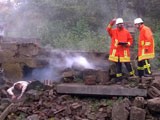 Five Fraunhofer institutes from different disciplines have teamed up for the Beyond Tomorrow project SENEKA – a sensor network with mobile robots for disaster management. The aim is to create a reliable and flexible system for saving human lives in an emergency, using sensors, communication technology elements and robots.
Five Fraunhofer institutes from different disciplines have teamed up for the Beyond Tomorrow project SENEKA – a sensor network with mobile robots for disaster management. The aim is to create a reliable and flexible system for saving human lives in an emergency, using sensors, communication technology elements and robots.
As a conclusion to the project, the research teams met on a training site at the German Federal Office of Civil Protection in Ahrweiler (AKNZ) at the end of 2014 to demonstrate how SENEKA could be deployed in emergency situations.
Entire districts may be devastated after a catastrophe, rendering existing maps practically useless for rescue operations. In many places, rescue workers have to find completely new routes. SENEKA offers a solution by taking autonomous ground and aerial robots and combining them with various wireless networked sensors to securely transmit current data to the rescue team.
The system is capable of combining information from various sources and creates an up-to-date map of the region: the software combines aerial images with 3D views of the destroyed areas on the ground, and recreates them in visual form in the mobile control station. Thanks to the resulting real-time overview, the rescue workers can quickly identify sources of damage and dangerous areas, assess the degree of destruction and target the search for survivors more effectively.
Best Price sensor probes
As part of SENEKA, the researchers also developed autonomous sensor probes that provide additional detail about the situation. In this way, Best Price sensor probes are dropped from aerial robots; from there, they find their own way into hard-to-reach spots in the rubble. They have chemical sensors for detecting gas and also feature an SOS button. Because the sensors can be located using the SENEKA radio network, victims trapped by debris who have drawn attention to themselves with the SOS button can be found by rescuers more quickly.
The SENEKA team is certain that getting humans and robots to work together will save more lives in the future.
www.fraunhofer.de
























































































